Projects and Features
Innovation key to progress
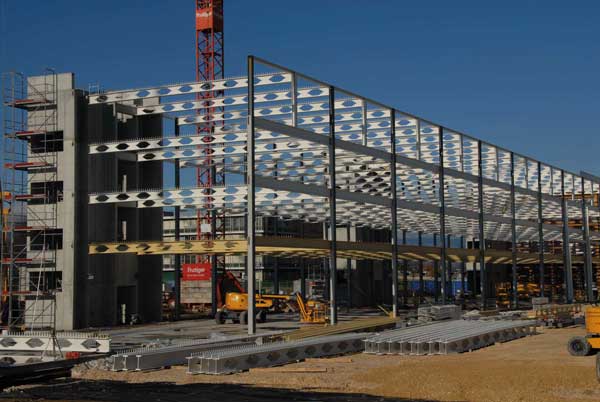
Angelina™ beams in use for construction
ArcelorMittal has been at the forefront of steel manufacturing technology developments since 1911 when Arbed, one of its constituents, rolled the world’s first one metre deep universal beam.
The ambition to stay at the forefront of developments in steel manufacturing has been maintained through the years since 1902 when ArcelorMittal rolled its first universal beam, developing into today’s multinational steel manufacturing force, standing just outside the top 100 of the world’s biggest companies as ranked in the Fortune Global 500.
Recent developments include the launch of its Orange Book design tool, and the company is also promoting high grade S460 steel and its innovative HISTAR® range in the UK market. The company says being able to manufacture larger and heavier sections enables engineers to cater for the changing and demanding requirements of their clients.
“Innovation and research and development remain a fundamental part of ArcelorMittal’s DNA,” says the company’s Neil Tilley. “Recently we have promoted the benefits of high grade steels that we have developed and made available to the UK market, where engineers are increasingly taking advantage of the benefits. Using high grade steels designers are able to reduce the weight of steel used in a structure or reduce column sizes in buildings to produce more usable space.”
Super Jumbo Sections are now used extensively in the UK market with column sizes up to 356 × 406 × 1299 and beams up to 1138 mm depth. The combination of strength and size offer gives designers more choice, whether designing tall slender skyscrapers or long-span roofs and bridges. Another benefit is the low carbon equivalent value (CEV) of HISTAR® steels, exhibiting toughness at low temperatures and increased weldability, allowing easier processing through fabrication workshops.
Mr Tilley said: “Designing in high strength steel chimes with today’s sustainability imperatives to do more with less weight. Cost savings of as much as 20% are being achieved by using high strength steels.”
ArcelorMittal’s HISTAR® range allows designers to utilise the full yield throughout the thickness range for HISTAR®355 and for HISTAR®460, dropping marginally to 450N/mm² only at thicknesses over 100mm. Cost-effective production of HISTAR® is made possible by the innovative“in line” Quenching and Self-Tempering (QST) process, developed by
ArcelorMittal Europe – Long Products in cooperation with the Centre de Recherches Métallurgiques in Liège. HISTAR® steels are delivered in accordance with the European Technical Approval ETA-10/156.
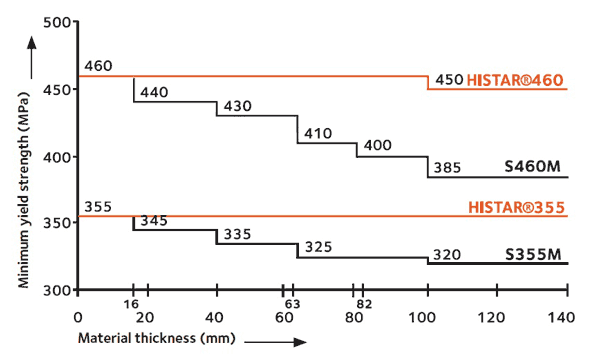
Figure 1: Comparison of yield strength between HISTAR® and other structural steel grades
Figure 1 (above) shows a comparison, based on yield strength, between HISTAR® and other standard structural steel grades. HISTAR® grades are compatible with the requirements of the Eurocodes for the design of steel structures and composite steel-concrete structures.
Weathering Steel Rolled Sections
ArcelorMittal also reports growing interest in weathering steel for exposed steel structures and bridges, where safety considerations for access and maintenance of protective systems is a consideration.
The company produces rolled sections in its Arcorox® weathering steel grade to EN 10025-5 in grades S355 J0W, J2W and K2W. Initial oxidation of Arcorox® forms a natural, tightly adherent, protective oxide layer (patina) which greatly reduces further oxidation and negates the need for a further protective system.
Angelina™ Beams
ArcelorMittal lays claim to an innovative and novel approach to service integration and long span composite beams that has resulted in the development of the Angelina™ beam. Based on a sinusoidal web cut, Angelina™ beams produce no waste from the cell formation and can accommodate single web openings for both circular and rectangular services. By varying the input to the sinusoidal equation, cells can be sized and positioned for greatest economy and efficiency, see Figure 2 below. Pre-design software for Angelina™ beams can be downloaded from http://sections.arcelormittal.com/download-center/design-software/castellated-beam-solutions.html
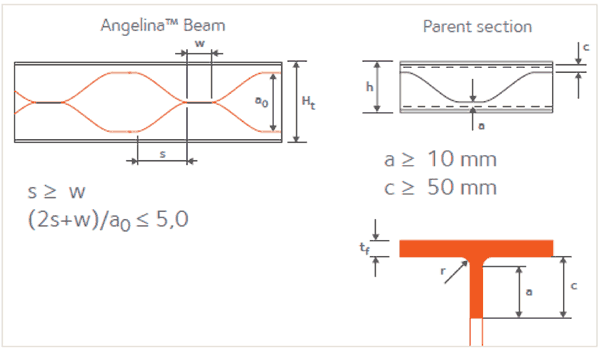
Figure 2. Geometric limits of the Angelina™ beam openings.
Neil Tilley concludes: “The advantages of our wide range of sections and high grade steels are becoming more popular with engineers. Recent work and collaboration with the Steel Construction Institute (SCI) to produce the Orange Book now means that engineers have quick access to seeing how moving to high grade steel benefits their design, and how the Eurocodes allow design advantage to be gained.”
Rolled section bridge solutions
ArcelorMittal reports an increasing demand for steel for use in bridge construction, valued for its unique combination of performance and safety. The company offers several bridge solutions utilising rolled sections in composite construction.
Neil Tilley said: “For spans of up to around 45m it is possible to use rolled sections as primary bearing elements in a series of bridge systems. Using our high grade steels in S460 and HISTAR®, along with a wide range of deep beams, longer spans for rolled section bridges can now be achieved than would have been previously been the case in the UK and Ireland.”
To enable engineers and designers to consider the benefits of rolled sections in composite bridges ArcelorMittal has developed a pre-design software called ACOBRI (ArcelorMittal Composite Bridges) in association with CTICM. This valuable pre-design tool enables competitive solutions to be produced for single and multi-span bridges in accordance with Eurocode (EN) regulations for road, railway and footbridges in a very quick and interactive way. It can be downloaded free from http://sections.arcelormittal.com.
ACOBRI supports design of a variety of alternative bridge solutions such as conventional composite multi-girder decks and ladder decks, and filler-beam decks, as well as the innovative Pre-CoBeam solutions.
“The output of the software involves a large amount of data,” says Mr Tilley. “Therefore, to enable clear interpretation and optimisation, a post-processing model is embedded in the software to enable clear visualisation, see Figure 3 (below). Other output data includes display of the influence lines, deflections or internal forces according to the loading type, all design checking criteria, stresses due to fatigue and the resulting fatigue category.”
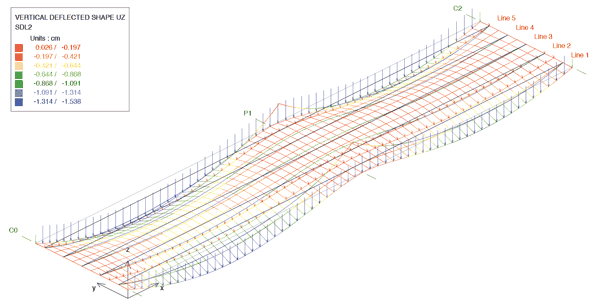
Figure 3: Visualisation of the model in the post-processor including loads, moments and deflected shape
The image below shows a filler-beam bridge deck capable of spanning 40m for single span and 50m for multiple spans in road bridges and 30m for single span and 35m for multiple spans in rail bridges. Advantages of filler-beam bridge decks include shallow depth for restricted headroom and monolithic construction that allows launching, in-situ deck casting or lifting of connected beams and lost formwork to reduce traffic disruption.
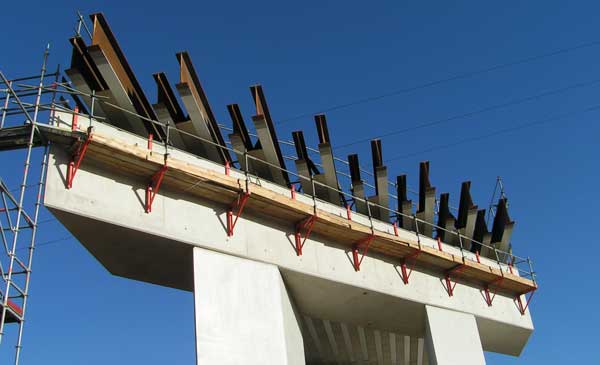
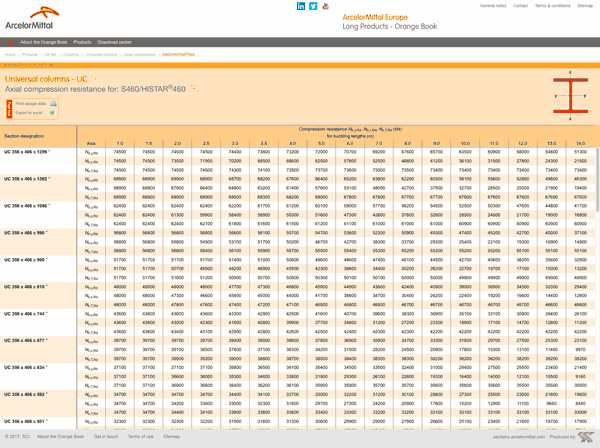
A typical page from the online Orange Book
Orange Book aids design
ArcelorMittal recently published its Orange Book in collaboration with the SCI. It can be accessed at http://orangebook.arcelormittal.com/
The Orange Book is an essential aid for the design of steelwork. Comprehensive tables of member resistances are given for S355/HISTAR®355 and S460/HISTAR®460 steel to enable rapid selection of steel members in compression, bending and tension. Tables are also provided for combined bending and compression, web resistance and shear resistance.
Section property data for rolled beams, columns, bearing piles, channels and angles are provided in the Orange Book, including effective section properties.
The design data are derived in accordance with the following Parts of Eurocode 3 and the UK National Annexes (NA):
- BS EN 1993-1-1:2005: Design of steel structures. Part 1-1: General rules and rules for buildings.
- BS EN 1993-1-5:2006: Design of steel structures. Part 1-5: Plated structural elements.
- BS EN 1993-1-8:2005: Design of steel structures. Part 1-8: Design of joints.
The resistances given in the Orange Book have been calculated using the partial factors given in the UK National Annexes for the Eurocodes (NA to BS EN 1993-1-1:2005 as published in December 2008, NA to BS EN 1993-1-5:2006 as published in May 2008 and NA to BS EN 1993-1-8:2005 as published in November 2008).
ArcelorMittal’s Orange Book covers the full range of section in BS EN 10365 which superseded BS 4-1 in January 2017.
David Brown, Associate Director at the SCI, said: “Over the past few years the default steel grade has migrated from S275 to S355. The availability of S460 now offers further advantages of increased capacity, leading to lighter weight and smaller section sizes.
“This is particularly true for compression members, where the buckling curve for higher strength steels leads to further economy. The Orange Book design tool enables engineers to quickly assess the advantage of building with higher strength steel sections.”
ArcelorMittal is a headline sponsor of Steel for Life
ArcelorMittal supports designers with an extensive range of free pre-design software and design guidance, all available from http://sections.arcelormittal.com.








